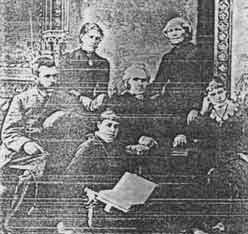|
 |
|
|
Photo courtesy of Saint John High School
Victoria School for
Girls
Saint John, New
Brunswick
|
|
"Gifts of
intellect and qualities of heart"
Mary Maude (Narraway) Sanford
(1860-1940)
"There is one collection in the Oriental Exhibition at
the Natural History Museum," wrote a Saint John Globe reporter in
1924, "before which every one stops, even if for but a moment, and that
is… the exhibit of gay little dolls loaned by Miss
Loretta Shaw and Mrs. Charles F. Sanford." The author went on to
declare that while there may have been rarer and far more
valuable exhibits in the Museum, "all the world loves a doll" and this stunning
demonstration of Japanese costume was enormously popular. It
appealed even to "those who are not interested in dolls for their own sweet
selves," but who could "not fail to appreciate the extreme daintiness of the
costumes."
| |
 |
| |
Archives & Special Collections, Harriet Irving Library,
University of New Brunswick (detail)
The
Narraway family
Maude is one of the two
youngest sisters (center front or right)
|
The doll-owner
identified as
Mrs. Charles Sanford was born Mary Maude Narraway near Saint John, New Brunswick, the
daughter of Methodist minister
Rev. James R.
Narraway and Hannah Close of England. "Maude"
received her secondary education at the Victoria Girls High School and went
on to train as a teacher at the Provincial Normal School in Fredericton,
where she passed the first-class teacher's license
exam with impressive marks. After sharpening her technique in the
Fredericton Model School, Maude secured a position as a teacher of
mathematics at Victoria Girls High School (later Saint John High School),
in an era when comparatively few women taught at the secondary level. A former student
praised her effective pedagogical style:
"In teaching mathematics, Miss Narraway
used to the full the character building element and taught us to love truth.
To all requests to be shown how to do a problem the answer was the same
'Oh, but you must do that yourself.'
Then with a suggestion here and a little help there our progress was
watched. At last we solved our problems and learned that all problems may be
solved by steady and persistent effort."
Miss Narraway was also a teacher of teachers. She served on the executive of the
provincial Educational Institute, and in 1891 she and fellow teacher Kate Bartlett read papers before a national education convention audience in
Toronto. But her thriving career came to an abrupt end in the summer of
1902. In their July-August issue, the editors of The Educational Review
expressed regret on behalf of the educational community at the retirement of
Miss Narraway, whose "career has been particularly successful." In the same
entry, they offered hearty congratulations to the new Mr. and Mrs. Charles Fenson Sanford.
Marriage at the age of
forty to a prominent Saint
John lawyer may have marked the end of Maude's public school career but, as
her contemporaries declared, "to teach was Mrs. Sanford's vocation and
delight," and she did not surrender it. She continued to pursue education in
other settings, teaching adult and youth Sunday School classes at the
Centenary Methodist Church and lecturing to women's groups on diverse
subjects. Her gifts as a lecturer were well known and in high demand, and
her talent for leadership earned for Sanford the distinction of being
the first President
of the United Church Women's Missionary Society Maritime Conference Branch,
and a delegate to the jubilee celebrations of Church missions in Trinidad. She
travelled extensively in North America and made two European tours, during
which her knowledge of the French and Italian languages must have proven a
great asset.
Maude
Sanford made numerous contributions to the New Brunswick
Museum. As an Associate (Auxiliary) member of the Natural History Society, she loaned or
gave over 300 international artefacts before her death in 1940. Early
accession records are vague, and it is unclear just how Sanford acquired so
many
fascinating objects from Japan, India, Africa, China, Syria,
Tibet, the Philippines and Palestine. In her capacity as Women's Missionary
Society leader, Maude was said to have "specially befriended all missionary
workers and all those from missionary lands who came to this country."
Perhaps these missionary friends were the source of Maude's ethnological artefacts, objects whose educational value she felt would benefit the
Museum, engage visitors, and "become
famous beyond the borders of their own mysterious [countries]."

Sources
 |
Educational
Review, June 1887; January 1890; June 1891; July-August 1902.
|
 |
MacLean, Faith D. and Ora P. MacCollum (Eds.)
Milestones in Methodism: a history of Centenary-Queen Square United
Church of Canada, Saint John, N. B., 1791-1966. Saint John, N. B.:
Lingley Printing Co., 1967.
|
 |
Saint John
Evening Times Globe,
13 September 1933.
|
 |
Saint John
Globe,
10 January 1924.
|
 |
Saint John
Telegraph-Journal,
19 August 1922; 24
January 1940.
|
|
|
From Her Collection
~~~~ |
![]()